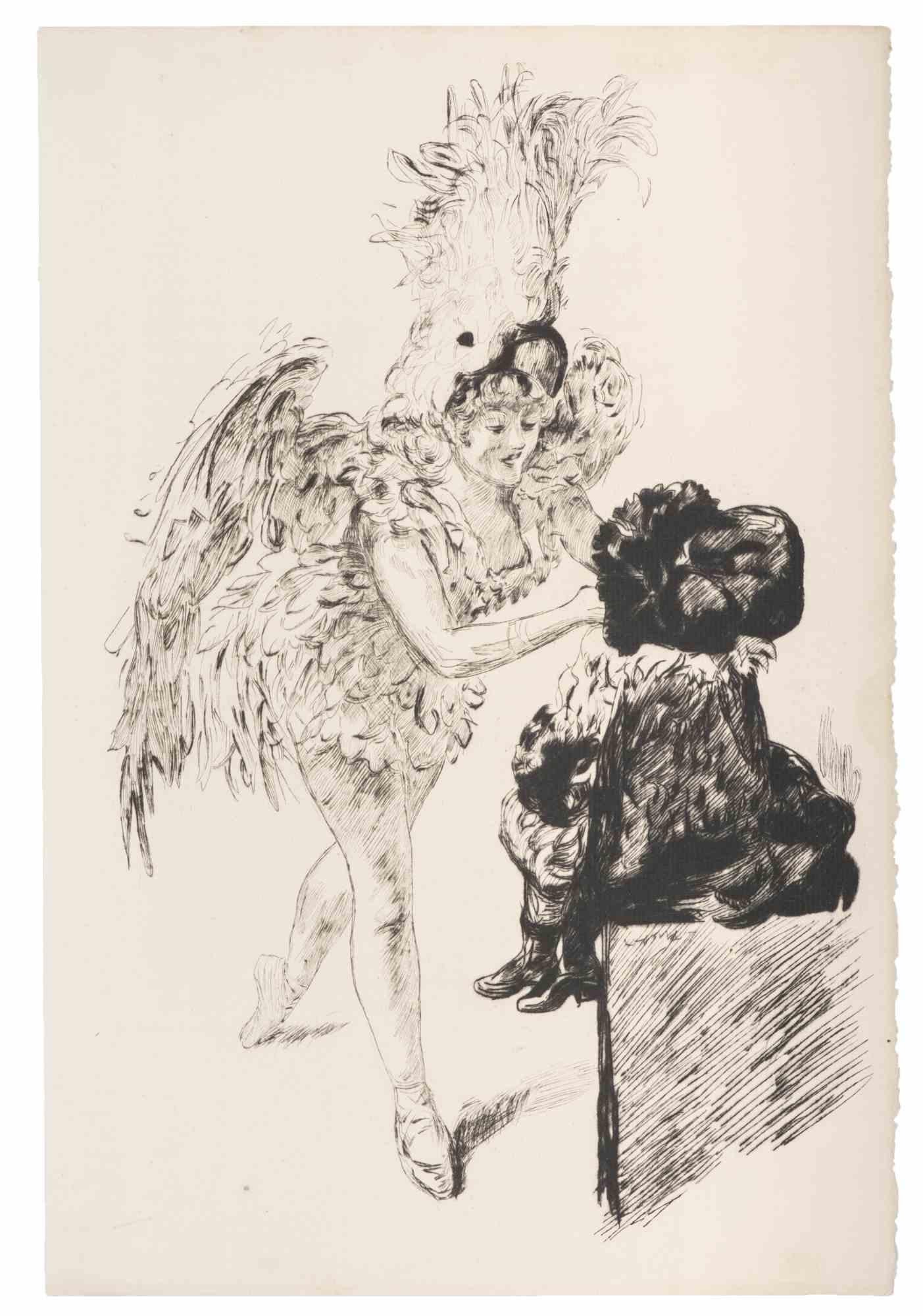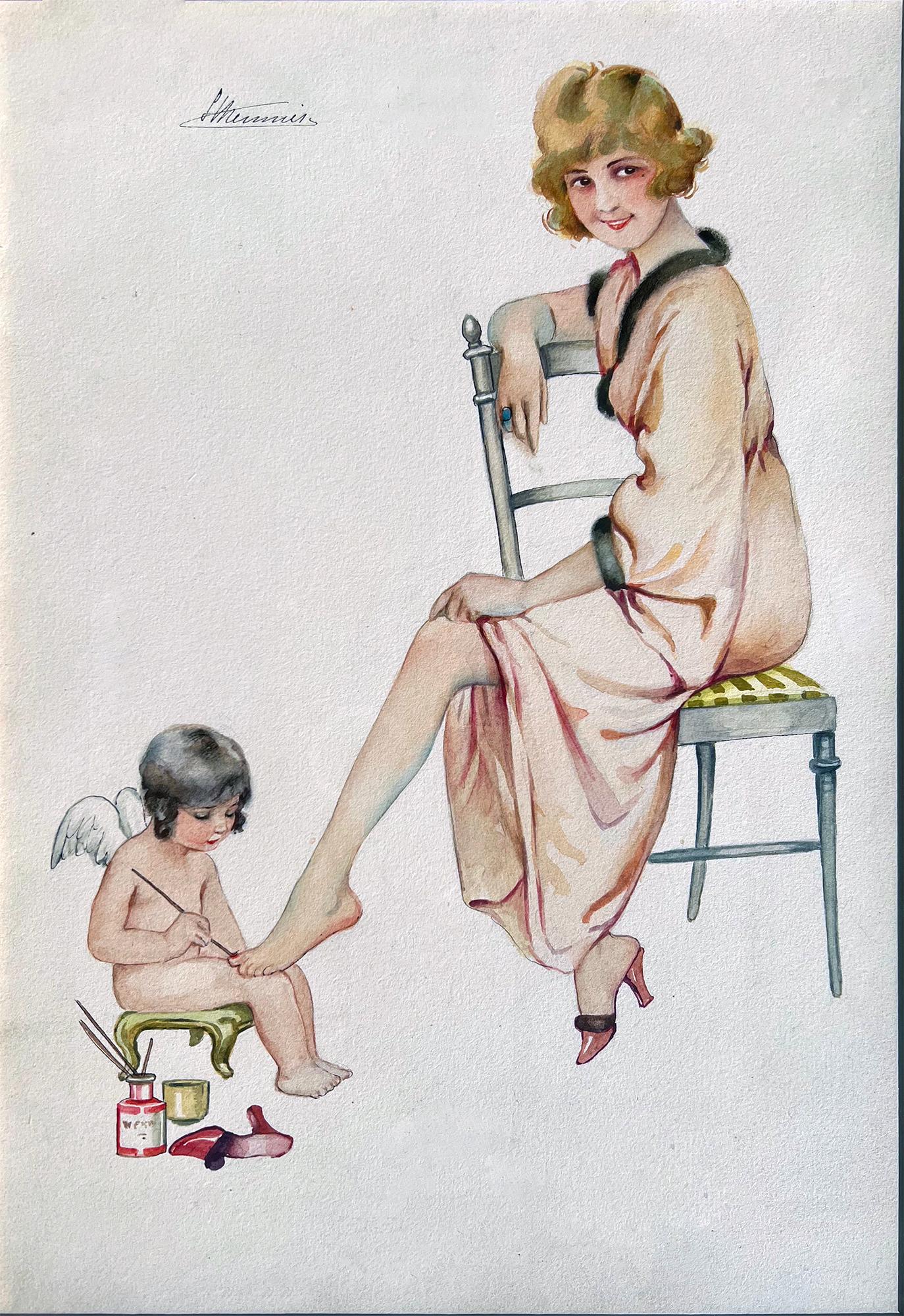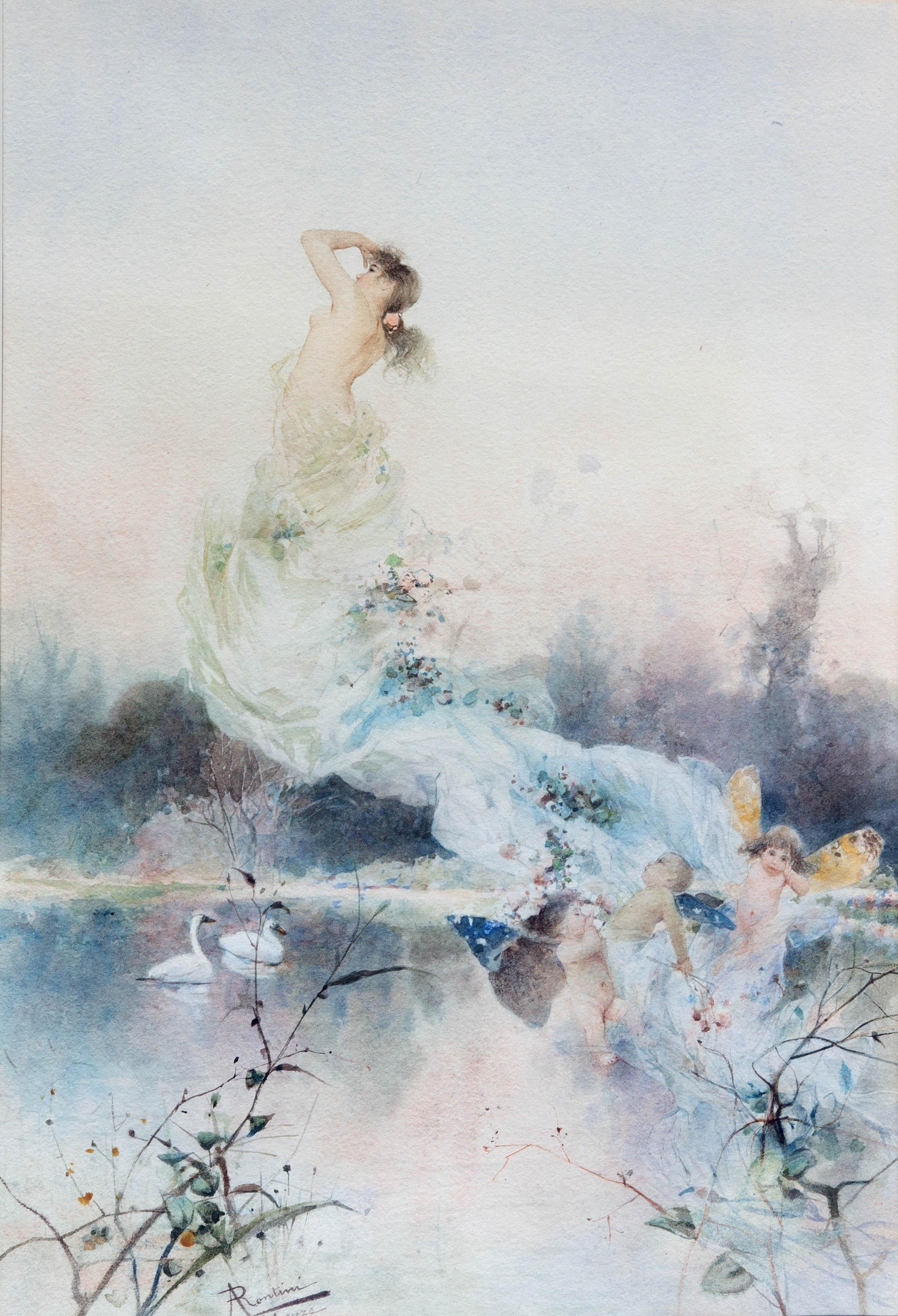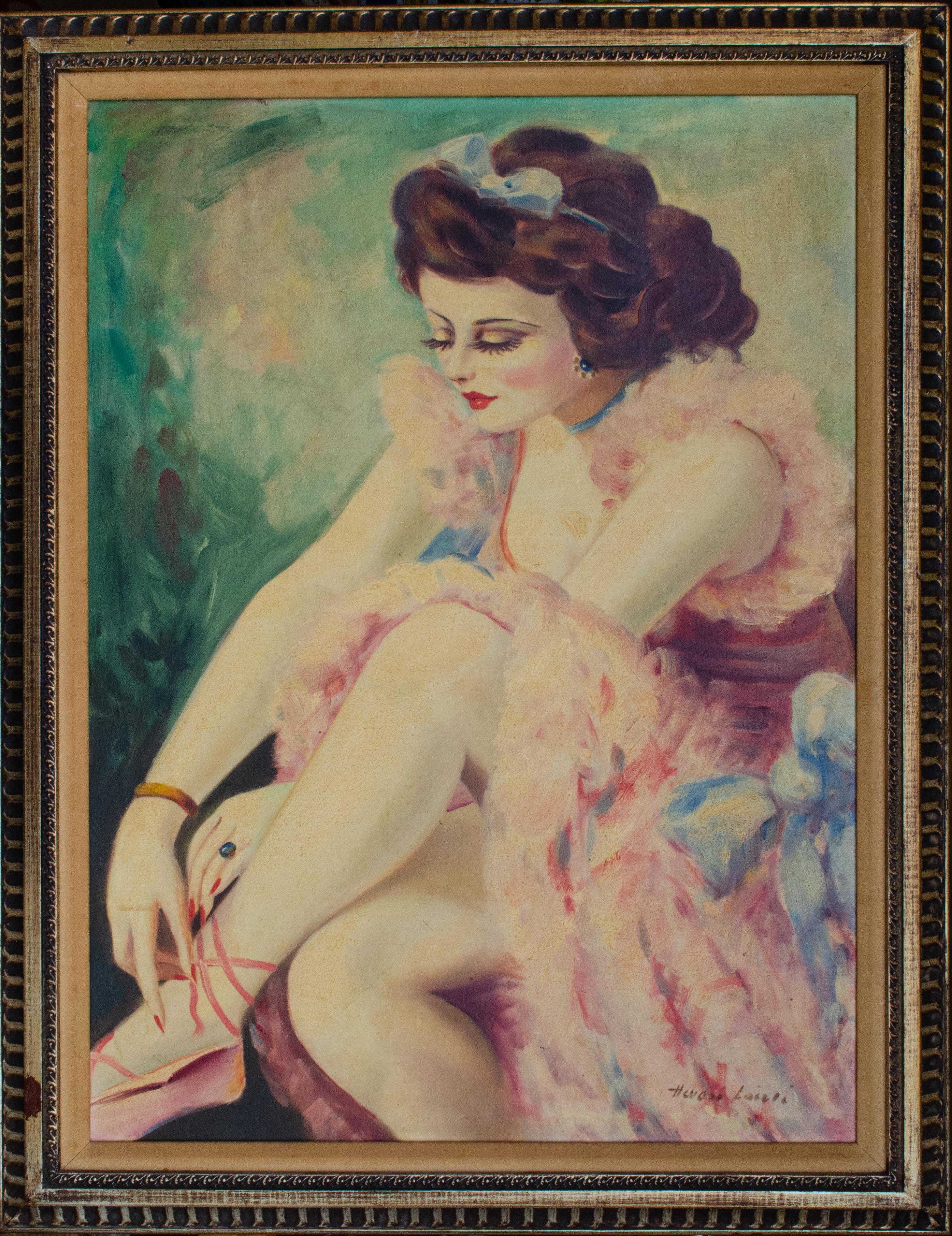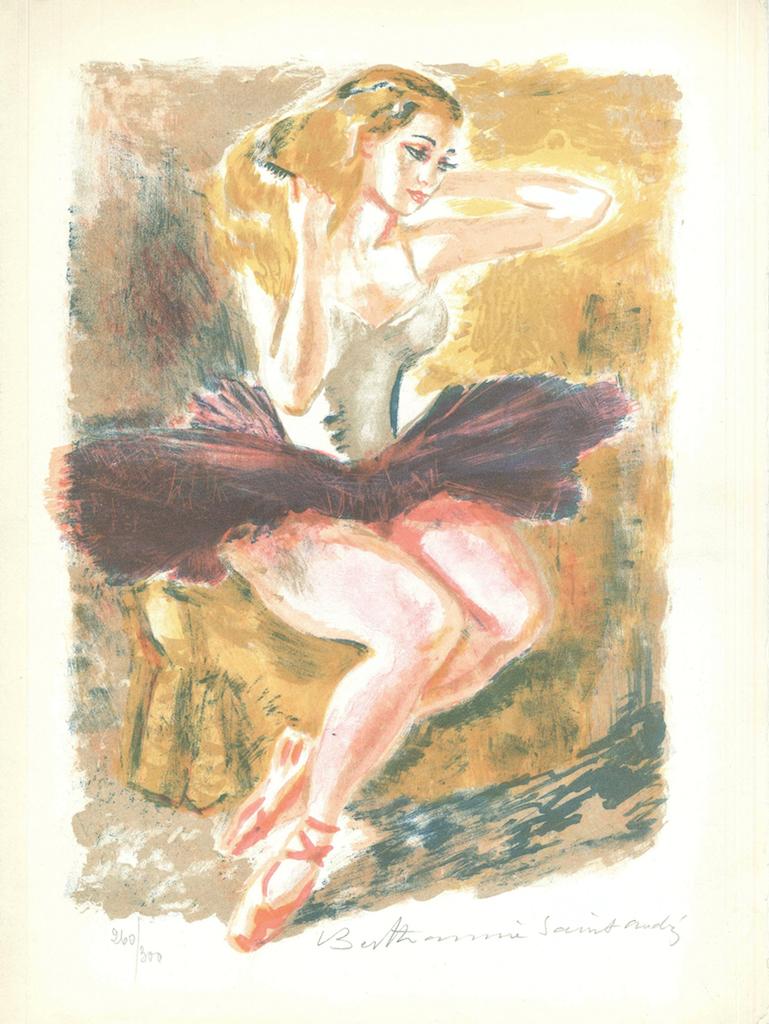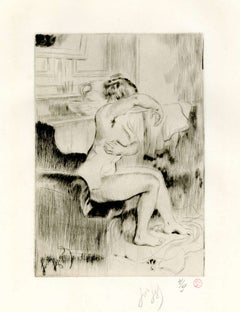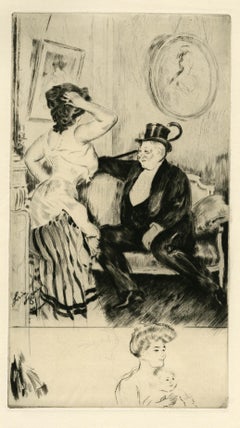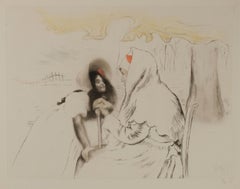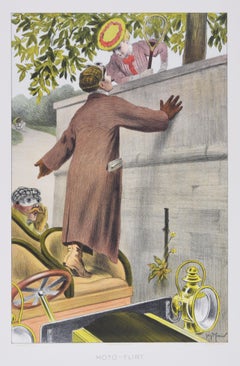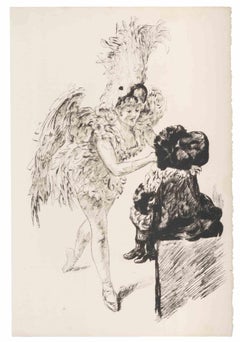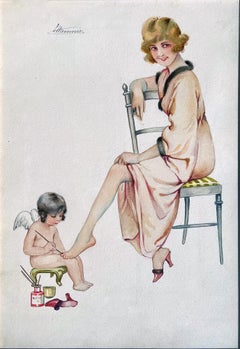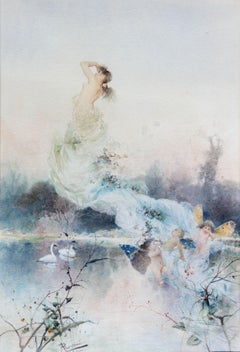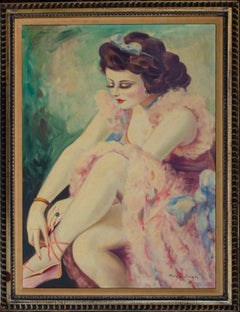Items Similar to Ballarina having make up applied by Cupid
Want more images or videos?
Request additional images or videos from the seller
1 of 9
Georges GrelletBallarina having make up applied by Cupidc. 1905
c. 1905
$1,250
£942.84
€1,087.70
CA$1,764.41
A$1,964.56
CHF 1,022.32
MX$23,711.88
NOK 12,820.83
SEK 12,110.08
DKK 8,120.48
About the Item
Ballarina having make up applied by Cupid
Watercolor and gouache on heavy wove paper, c. 1905
Signed in ink lower right
Titled in pencil, verso
Condition: Aging to sheet
Colors fresh and vibrant
Image size: 19 5/8 x 12 3/4 inches
Grellet was a noted French Art Deco designer
François Georges Grellet (1869-1959) was a French painter , engraver and illustrator .
Biography
Born on October 9, 1869 in Tours , Georges Grellet came from a family originally from Saumur.
A student at the Beaux-Arts in Paris from 1890, he began to produce drawings for the press, titles such as Paris-Joyeux (1894), Le Journal pour tous , La Caricature (1895-1902), Gil Blas illustré , Fin de siècle , Le Rire , La Vie pour rire (1900), L'Album comique de la famille (1903), L'Indiscret , Le Sourire (1917-1921), Ridendo (1934-1940), Scaramouche (1936). He signed some of his compositions "Géogrell" and was a member of the Humoristes.
In 1905, in Boulogne (Hauts-de-Seine), he married a young artist, Hortense Vuischard, cousin of the painter Jules-Charles Aviat, to whom Georges was related .
During the First World War , he made many drawings of the front. Concerning the mosaic located in the apse of the Notre-Dame de Brebières basilica , it was designed from the drawings of a namesake, Alexandre Grellet. This mosaic was destroyed during the conflict, then restored.
Grellet produced lithographed advertising posters such as À la Place Clichy and Au Bon Marché (1900). He designed the character of "Doctor Valda" for the pastilles of the same name.
In the 1920s, he collaborated on the albums of the "L'Estampe moderne" company directed by Octave Bernard , including numerous original color etchings and stencil illuminations, which depict elegant young women in a "boudoir" style .
Grellet was also an illustrator for literary works such as La Cousine Bette by Balzac, or La Route solitaire by Claude Du Val (1937).
He died on March 30, 1959 in the 18th arrondissement of Paris.
- Creator:Georges Grellet (1870 - 1959, French)
- Creation Year:c. 1905
- Dimensions:Height: 19.63 in (49.87 cm)Width: 12.75 in (32.39 cm)
- Medium:
- Movement & Style:
- Period:
- Condition:
- Gallery Location:Fairlawn, OH
- Reference Number:Seller: FA56331stDibs: LU14015513142
About the Seller
5.0
Recognized Seller
These prestigious sellers are industry leaders and represent the highest echelon for item quality and design.
Gold Seller
Premium sellers maintaining a 4.3+ rating and 24-hour response times
Established in 1978
1stDibs seller since 2013
807 sales on 1stDibs
Typical response time: <1 hour
Associations
International Fine Print Dealers Association
- ShippingRetrieving quote...Shipping from: Akron, OH
- Return Policy
Authenticity Guarantee
In the unlikely event there’s an issue with an item’s authenticity, contact us within 1 year for a full refund. DetailsMoney-Back Guarantee
If your item is not as described, is damaged in transit, or does not arrive, contact us within 7 days for a full refund. Details24-Hour Cancellation
You have a 24-hour grace period in which to reconsider your purchase, with no questions asked.Vetted Professional Sellers
Our world-class sellers must adhere to strict standards for service and quality, maintaining the integrity of our listings.Price-Match Guarantee
If you find that a seller listed the same item for a lower price elsewhere, we’ll match it.Trusted Global Delivery
Our best-in-class carrier network provides specialized shipping options worldwide, including custom delivery.More From This Seller
View AllLa Toilette
By Louis Legrand
Located in Fairlawn, OH
La Toilette
Drypoint, 1908
Signed and numbered in pencil by the artist (see photos)
Edition: 65 this state (35/65)
Published by Gustave Pellet (1859-1919),...
Category
Early 1900s Art Nouveau Figurative Prints
Materials
Drypoint
En passant (Passing by)
By Louis Legrand
Located in Fairlawn, OH
En passant (Passing by)
Drypoint, 1909
Unsigned (as issued in the deluxe portfolio)
From the album "Les Bars" (8 plates plus cover illustration)
Edition: 30, this state with remarque
Published by Gustav Pellet, Paris
A very rich impression wwith burr
Condition: Excellent
Image/Plate size: 9 7/8 x 6 3/8 inches
Reference: Arwas 391a (remarque)
Exteens 277 i/II
IFF 148 (portfolio)
Louis Auguste Mathieu Legrand (29 September 1863 – 1951) was a French artist, known especially for his aquatint engravings, which were sometimes erotic. He was awarded the Légion d'honneur for his work in 1906.
Life
Legrand was born in the city of Dijon in the east of France. He worked as a bank clerk before deciding to study art part-time at Dijon's Ecole des Beaux-Arts. He won the Devosge prize at the school in 1883.[2] In 1884 Legrand studied engraving under the Belgian printmaker Félicien Rops.
Legrand's artworks include etchings, graphic art and paintings. His paintings featured Parisian social life. Many were of prostitutes, dancers and bar scenes, which featured a sense of eroticism. According to the Hope Gallery, "Louis Legrand is simply one of France's finest early twentieth century masters of etching." His black and white etchings especially provide a sense of decadence; they have been compared to those of Henri de Toulouse-Lautrec, though his drawings of the Moulin Rouge, the can-can dance and the young women of Montmartre preceded Toulouse-Lautrec's paintings of similar scenes. He made over three hundred prints of the night life of Paris. They demonstrate "his remarkable powers of observation and are executed with great skill, delicacy, and an ironic sense of humor that pervades them all."
Two of his satirical artworks caused him to be tried for obscenity. The first, "Prostitution" was a symbolic drawing which depicted a naked girl being grasped by a dark monster which had the face of an old woman and claws on its hands; the second, "Naturalism", showed the French novelist Émile Zola minutely studying the thighs of a woman with a magnifying glass. Defended by his friend the lawyer Eugène Rodrigues-Henriques (1853–1928), he was found not guilty in the lower court, but was convicted in the appeal court and then given a short prison sentence for refusing to pay his fine.
Legrand was made famous by his colour illustrations for Gil Blas magazine's coverage of the can-can, with text by Rodrigues (who wrote under the pseudonym Erastene Ramiro). It was a tremendous success, with the exceptional quantity of 60,000 copies of the magazine being printed and instantly sold out in 1891.
In 1892, at the instigation of the publishing house Dentu, Legrand made a set of etchings of his Gil Blas illustrations. The etchings were published in a book, Le Cours de Danse Fin de Siecle (The End of the Century Dance Classes).
Legrand took a holiday in Brittany, which inspired him to engrave a set of fourteen lithographs of simple country life called Au Cap de la Chevre (On Goat Promontory). It was published by Gustave Pellet who became a close friend of Legrand's. Pellet eventually published a total of 300 etchings by Legrand, who was his first artist; he also published Toulouse-Lautrec and Félicien Rops among others.
He did not only work in graphics; he exhibited paintings at the Paris salon of the Société Nationale des Beaux-Arts starting in 1902. In 1906 he was made a chevalier of the Légion d'honneur.
Legrand died in obscurity in 1951. A retrospective exhibition was held at the Félicien Rops museum in Namur, Belgium in 2006 to celebrate his graphic art. The art collector Victor Arwas published a catalogue raisonné for the occasion.
Books illustrated
de Maupassant, Guy: Cinq Contes Parisiens, 1905.
Poe, Edgar Alan: Quinze Histoires d'Edgar Poe...
Category
Early 1900s Art Nouveau Interior Prints
Materials
Drypoint
L'Aieule (The Grandmother)
By Louis Legrand
Located in Fairlawn, OH
L'Aieule (The Grandmother)
Etching and aquatint printed in colors, 1904
Signed with the red stamp of the publisher, Gustave Pellet, Lugt 1193 and numbered (see photo)
Edition: 100 (81/100)
Reference: Arwas 202 iv/IV
IFF 98
Condition: Excellent, the sheet aged as usual
Image size: 14 1/4 x 18 5/8"
Sheet size: 16 15/16 x 24 1/4"
Louis Auguste Mathieu Legrand (29 September 1863 – 1951) was a French artist, known especially for his aquatint engravings, which were sometimes erotic. He was awarded the Légion d'honneur for his work in 1906.
Life
Legrand was born in the city of Dijon in the east of France. He worked as a bank clerk before deciding to study art part-time at Dijon's Ecole des Beaux-Arts. He won the Devosge prize at the school in 1883.[2] In 1884 Legrand studied engraving under the Belgian printmaker Félicien Rops.
Legrand's artworks include etchings, graphic art and paintings. His paintings featured Parisian social life. Many were of prostitutes, dancers and bar scenes, which featured a sense of eroticism. According to the Hope Gallery, "Louis Legrand is simply one of France's finest early twentieth century masters of etching." His black and white etchings especially provide a sense of decadence; they have been compared to those of Henri de Toulouse-Lautrec, though his drawings of the Moulin Rouge, the can-can dance and the young women of Montmartre preceded Toulouse-Lautrec's paintings of similar scenes. He made over three hundred prints of the night life of Paris. They demonstrate "his remarkable powers of observation and are executed with great skill, delicacy, and an ironic sense of humor that pervades them all."
Two of his satirical artworks caused him to be tried for obscenity. The first, "Prostitution" was a symbolic drawing which depicted a naked girl being grasped by a dark monster which had the face of an old woman and claws on its hands; the second, "Naturalism", showed the French novelist Émile Zola minutely studying the thighs of a woman with a magnifying glass. Defended by his friend the lawyer Eugène Rodrigues-Henriques (1853–1928), he was found not guilty in the lower court, but was convicted in the appeal court and then given a short prison sentence for refusing to pay his fine.
Legrand was made famous by his colour illustrations for Gil Blas magazine's coverage of the can-can, with text by Rodrigues (who wrote under the pseudonym Erastene Ramiro). It was a tremendous success, with the exceptional quantity of 60,000 copies of the magazine being printed and instantly sold out in 1891.
In 1892, at the instigation of the publishing house Dentu, Legrand made a set of etchings of his Gil Blas illustrations. The etchings were published in a book, Le Cours de Danse Fin de Siecle (The End of the Century Dance Classes).
Legrand took a holiday in Brittany, which inspired him to engrave a set of fourteen lithographs of simple country life called Au Cap de la Chevre (On Goat Promontory). It was published by Gustave Pellet who became a close friend of Legrand's. Pellet eventually published a total of 300 etchings by Legrand, who was his first artist; he also published Toulouse-Lautrec and Félicien Rops among others.
He did not only work in graphics; he exhibited paintings at the Paris salon of the Société Nationale des Beaux-Arts starting in 1902. In 1906 he was made a chevalier of the Légion d'honneur.
Legrand died in obscurity in 1951. A retrospective exhibition was held at the Félicien Rops museum in Namur, Belgium in 2006 to celebrate his graphic art. The art collector Victor Arwas published a catalogue raisonné for the occasion.
Books illustrated
de Maupassant, Guy: Cinq Contes Parisiens, 1905.
Poe, Edgar Alan: Quinze Histoires d'Edgar Poe...
Category
Early 1900s Art Nouveau Figurative Prints
Materials
Aquatint
Moto-Flirt
By Georges Meunier
Located in Fairlawn, OH
Moto-Flirt
Color lithograph, c. 1902
Signed in the stone lower right (see photo)
Published by Edmund Sagot (1857-1917), Paris
Printed by Atelier Chaix, Paris
Large edition with title...
Category
Early 1900s Art Nouveau Figurative Prints
Materials
Lithograph
L'heure de Berger (Hour of the Shepherd)
By Hans Christiansen (b.1866)
Located in Fairlawn, OH
L'heure de Berger (Hour of the Shepherd)
Color lithograph, 1898
Signed in the stone lower right
As published in L'Estampe Moderne, Paris, March, 1898
Edition: 2000 (there was also a ...
Category
1890s Art Nouveau Nude Prints
Materials
Lithograph
Retour (Homecoming)
By Georges De Feure
Located in Fairlawn, OH
Retour
Color lithograph, 1897
Signed in the stone lower left edge of the image (see photo)
As published in "L'Estampe Moderne"
L'Estampe Moderne appeared each month as a portfolio of...
Category
1890s Art Nouveau Figurative Prints
Materials
Lithograph
You May Also Like
The Ballerina - Lithograph by Adolphe Willette - Late 19th century
By Adolphe Willette
Located in Roma, IT
The Ballerina is an original lithograph realized by Adolphe Willette (1857-1926) in the late 19th century.
Good condition.
Adolphe-Léon Willette (Châlons-sur-Marne, 1857 - Parigi, ...
Category
Late 19th Century Art Nouveau Figurative Prints
Materials
Lithograph
Risque Pedicure by Angel, Les Ongles, Boudoir style, Female Illustration
By Suzanne Meunier
Located in Miami, FL
This Illustration Boudoir style Illustration by Female Illustrator Suzanne Meunier was done on an assignment for a French Postcard. It's a very early ...
Category
1910s Art Nouveau Figurative Drawings and Watercolors
Materials
Watercolor
Art Nouveau Painting of a Maiden and Mischievous Cupids 19th Century by Rontini
Located in Rochester, NY
Art nouveau painting of beautiful maiden and mischievous angels. An allegory of Spring. Watercolor. Signed painting by Alessandro Rontini (Italian born 1854). In beautiful custom flo...
Category
19th Century Art Nouveau Figurative Paintings
Materials
Watercolor
Art Nouveau Ballerina Painting by Mystery European Artist
Located in New York, NY
Mystery European Artist
Untitled, c. 20th Century
Oil on canvas board
31 x 22 3/4 in.
Framed: 36 1/4 x 28 x 1 1/2 in.
Signed lower right
Category
20th Century Art Nouveau Figurative Paintings
Materials
Canvas, Oil, Board
Dancer Combing Hair - Lithograph by L. B. Saint-André - Early 20th Century
By Louis Berthomme Saint-Andre
Located in Roma, IT
Dancer Combing her Hair is an original lithograph realized by Louis Berthomme Saint-André in the 20th Century.
Hand-signed in pencil on the lower right corner. Numbered on the lowe...
Category
Early 20th Century Contemporary Figurative Drawings and Watercolors
Materials
Lithograph
Before the Ballet - Original lithograph - 1897
By Charles Paul Renouard
Located in Paris, IDF
Paul RENOUARD
Before the Ballet
Original lithograph
Printed signature in the plate
1897/98
On vellum 40 x 31 cm (c. 16 x 12")
INFORMATION : Published by 'Estampe Moderne, Paris, 18...
Category
1890s Art Nouveau Figurative Prints
Materials
Lithograph
